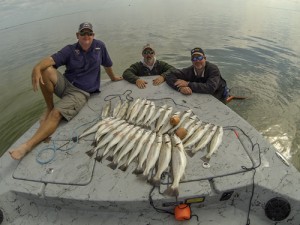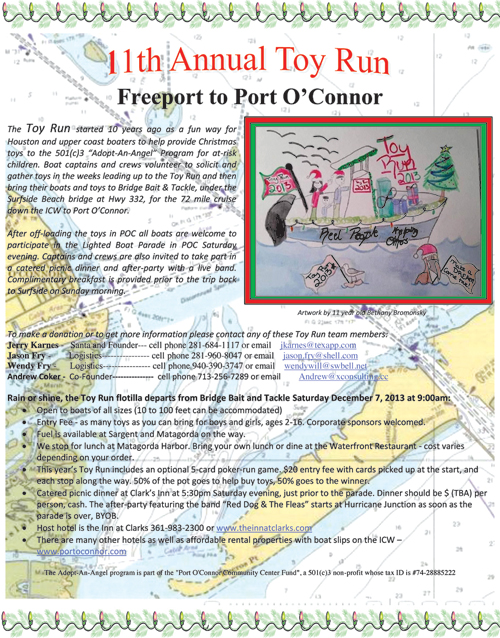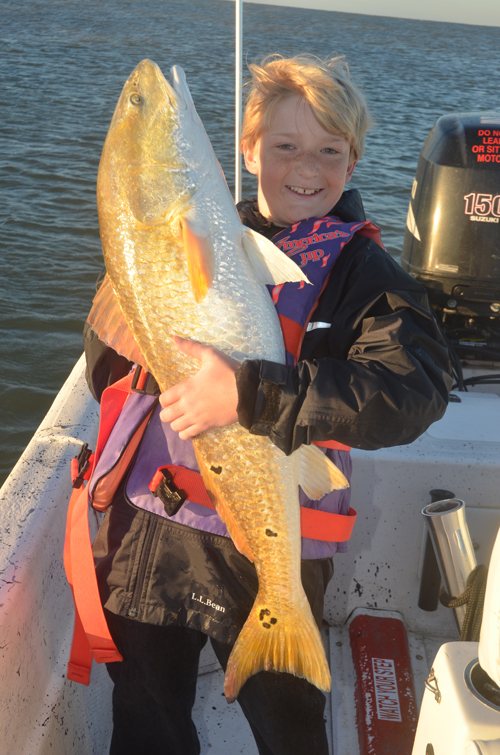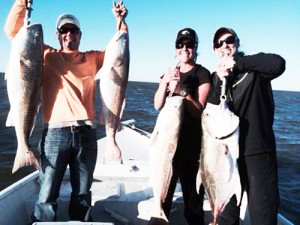Toy Run December 7!
Big Birthday Catch!
Rough Weather – Good Catch
“We fished Saturday, 19th, and despite VERY rough waters and high wind getting out to the big jetties around 1:15 pm. By 2:00 or so the winds had died down and the fishing was beyond amazing. Reds were all over the place- we reeled in 26 all over 34” and had two break our lines on the way in. The photo above captures the three of us with the reds we reeled in, and the Jack that had broken our lines earlier, but somehow got tangled into our lines when we caught our reds and we managed to pull in 4 fish with 3 hooks!”
“Plan on Plastic” Guide Lines, by Capt. Chris Martin

Bay Flats Lodge Guide Jason Wagenfehr took advantage of oyster shell wade fishing in San Antonio Bay using plum chartreuse Norton Sand Eels Jr. and top water lures in bone.
The weather has simply been beautiful lately. Things have cooled off a bit, but not to the point to where it is uncomfortable to be out on the water fishing. And, we’ve been fortunate enough to have received some much needed rain in our area and around the rest of the state as well. But there’s one thing we’ve been even more lucky with, and that is our recent catches of autumn trout. Fishing with dark plastic baits has been the ticket as of late, and we won’t change a thing until Mother Nature instructs us to do so. She’s been good to us so far this fall, but like everything else in life, change is inevitable. Until the weather does finally decide to take a turn for the worse later in the year, we’ll just keep on having fun with what we know works the best.
Right now we’re experiencing good results over tapered shell that happens to be mixed with a hint of soft sand or mud. We’re starting out early each morning, and generally don’t have to fish much past noon in order to recognize notable success. Aside from those who have been tossing live bait under a popping cork while anchored in a boat or while drifting, the wading anglers who have been throwing some of the darker colors – roach, black-magic, and plum/chartreuse – of flapping plastics have been realizing some of the greatest benefits. Some of the best action is experienced just as the morning sky begins to brighten by the brilliance and sudden appearance of the sun over the morning horizon, especially on those mornings that happen to follow nights having no moon.
We choose to stay with these dark-color plastic lures, especially throughout this time of the year, because they work. There’s less hours of daylight right now, and these darker colors are able to cast a significant silhouette to the fish below through almost any water condition as the light in the sky shines behind the lure. Notice that I said almost any water condition. What I’m trying to say here is that I have found that these darker colors seem to be equally as effective in dirty or stained water as they are in green or clear water. Simply put, I’d probably recommend to any angler the pursuit of dark lures when chasing cool-water trout and reds during this period of the year.
If you have been a die-hard live-bait enthusiast for most of your fishing career, and you aren’t quite sure whether you’re ready to transition to the use of artificial baits, I might recommend you use the month of November to acquaint yourself with top water baits. My November fishing logs are filled with success stories where top water baits were the hero of the day. They are relatively easy baits to use, and even the novice can recognize reward after just a little bit of practice time. If you take it upon yourself to learn to walk-the-dog this month, you may just find yourself pleasantly surprised with the results that you are able to manage.
If you do decide to try the game on top, you might become overwhelmed by the many different styles, colors, and sizes of top water baits available to anglers today. I would suggest that you try to keep things as simple as possible, especially if you’re just starting out. Grab yourself a bone-colored She Dog and practice, practice, practice. It’s a good all-around color, manageable size, and it walks across the surface with ease. And who knows, you might even be lucky enough to entice one of those ever-popular speckled followers!
As this edition of Guide Lines goes to print, we will have already completed the opening weekend of what we all hope will be a truly great duck season. So, give us a call if you’re interested in a Blast & Cast adventure for this year’s season, where we hunt ducks in the morning, then surrender our shotguns for fishing poles for a fun-filled afternoon of great coastal fishing. Now is the time to book your trip! Remember to practice CPR, “Catch, Photo, and Release”, whenever possible on trophy Trout and Reds…Guide Chris Martin, Port O’Connor/Seadrift region. www.BayFlatsLodge.com…1-888-677-4868
Shell Continues Major Commitment to Gulf Marine Habitat
Historic partnership with CCA habitat program to continue another three years
Coastal Conservation Association and Shell Oil Company have announced an extension of their unique partnership that has already produced more than a dozen significant marine habitat restoration projects along the Gulf Coast over the past two years. Shell’s decision to fund $500,000 over each of the next three years will enable CCA’s Building Conservation Trust to continue providing vital funding for grassroots-driven marine habitat projects.
“The program is achieving every goal that we set when we first discussed the need for a sustainable marine habitat program with Shell in 2010,” said Patrick Murray, president of CCA. “This is a relationship that has drawn on the best of private industry, public stewardship and our sporting tradition to enhance our coasts. We are proud to be working with our partners at Shell to not only create new habitat, but to advance the science of habitat restoration and marine fisheries conservation. It’s been a fantastic partnership by any metric.”
The company’s original commitment of $1.5 million to the CCA Building Conservation Trust (BCT) in 2010 was one of the company’s largest contributions ever given to a non-profit organization engaged in this type of conservation work. Over the first two years of the program, $1 million in BCT funding was matched by more than $1.6 million from various partners in both the private and public sectors to place reefs in places such as Barataria Bay, Louisiana, Mobile Bay, Alabama, and off Matagorda, Texas.
In one of its more innovative projects, BCT was able to advance marsh restoration science with “floating islands” technology in Terrebonne Parish, Louisiana. The project brought together students from local schools, members of a local Native American tribe, CCA volunteers and Shell employees to rebuild 2,500 linear feet of shoreline. For its support of the project, Shell earned the 2013 Gulf Guardian Award bestowed by the Gulf of Mexico Program, an initiative of the U.S. Environmental Protection Agency to facilitate collaborative actions to protect, maintain, and restore the health and productivity of the Gulf of Mexico.
The CCA Building Conservation Trust was created exclusively to fund marine habitat creation and restoration in areas that can be accessed and enjoyed by recreational anglers, and that achieve one or more of five key objectives: restore degraded habitats, create new habitats, advance the science of habitat restoration and conservation; foster habitat stewardship and educate on the value of conservation to coastal communities.
“Shell’s generosity and vision have meant more reefs, more marsh restoration, more research and more science to sustain marine resources all along the coast,” said Murray. “This is a commitment that is deeply appreciated and understood by all sportsmen, particularly by the marine recreational angling community.”
For a complete listing of BCT projects and information on the scope of the program’s restoration efforts, visit the CCA website, at www.JoinCCA.org.




